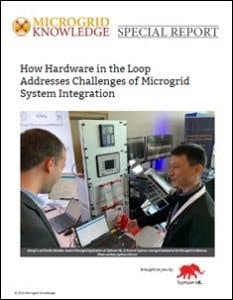In the sixth and final article of this special report series brought to you by Microgrid Knowledge and Typhoon HIL, we’re presenting two examples of organizations that have used Hardware in the Loop (HIL) to validate their microgrid systems. An additional case study is available exclusively in the full report.
Get the full report.
CASE STUDY 1: Duke Energy | Increasing confidence with Hardware in the Loop testing
Duke Energy, providers of microgrid solutions since 2013, decided to start using HIL because it did not want to learn by making mistakes on real customer circuits. Prior to HIL, the organization used open loop static based simulations such as Simulink but found large discrepancies between the performances of actual equipment during validation tests against the open loop models. This is not to say that HIL models are immediately 100% accurate, but the closed loop system allows feedback to be used to fine-tune the HIL models.
“Once that piece of equipment is validated in your HIL, your confidence is high, but there’s an upfront process to get through. The hope is once you have that repository of different building blocks, future deployments of future systems should benefit.” — Stuart Laval, technology director, Duke Energy
For the time being, microgrids are custom-made, as they must integrate into existing power systems and coordinate with protection devices. Distributed energy resource (DER), inverter-based systems present different challenges to synchronous generators, such as the design of effective grounding, protection and control.
For a microgrid with a mix of DERs, the battery becomes critical for managing islanding and synchronizing with other DERs and the grid system. As the battery becomes the focal point, its business case has to be justified, with additional value coming from the provision of grid services. As such, there is a requirement for the ability to island and reconnect seamlessly. This leads to the need to understand fault responses of inverters in power electronics-based resources in grid connected and islanded modes, which is where HIL testing comes into its own.
HIL testing allows Duke Energy to build full, closed loop systems and model the fidelity of proportional-integral-derivative (PID) controllers of inverters to understand the fault response with transience on the grid and existing control schemes. Duke Energy found that HIL gives a better picture of system dynamics without impacting customers because it is done off the grid in a lab environment.
“Utilities have built microgrids without HIL, made technology decisions blindly without understanding full system dynamics. HIL would have provided value and helped with understanding the use cases and impact from a protection control perspective.” — Stuart Laval, technology director, Duke Energy
Looking ahead, Duke Energy is developing “cookie cutter” scalable, repeatable microgrid components and says that HIL is a “no-brainer” for this. HIL becomes an under-the-hood, digital twin for these plug-and-play microgrids. New algorithms can be trialed and new control schemes can be validated before roll out for the customers. Site testing and debugging of software can also be completed ahead of deployment.
There is, of course, an upfront investment and process for the use of HIL. For Duke Energy, which develops many microgrid systems, this is worthwhile. HIL provides vital understanding of how equipment will integrate with existing power systems.
CASE STUDY 2: Rolls Royce | Reducing surprises in the field
Rolls Royce Power Systems, a system integrator, runs microgrids across the globe. It originally set out to deliver plug-and-play storage solutions to enable customers to integrate solar power and wind, but realized that for this to work it had to deliver microgrid controllers. A centralized controller was developed; the same controller for every microgrid, with an abstract model of the different possible DER assets to allow customization for different microgrid setups.
Initially, Rolls Royce carried out microgrid integration testing at a demonstration facility. A prototype battery system, a genset and other equipment allowed for quick results. With around 50 running microgrids in the field, a growing customer base and increasing complexity, testing at the demonstration facility became impractical. The alternative option, testing in the field, carried too much risk for the customer. As such, Rolls Royce sought a better solution to ensure equipment was correctly integrated and the control system worked as expected, and HIL fit the bill.
As a system integrator, Rolls Royce takes off-the-shelf equipment and brings it together to make an AC coupled battery storage system. This is then integrated with the whole microgrid, and Rolls Royce ensures all the different parts work together.
“Documentation is only a start when you work with these components. You always learn something new in the field.” — David Dunnett, head of software development, Rolls Royce
Using HIL testing allows Rolls Royce to reduce surprises in the field, making commissioning easier and faster. With customers in Indonesia, Haiti and Greenland, to name a few locations, reducing surprises also helps to cut travel time and cost for engineers and technicians.
“We have a long list of existing energy equipment that we can already talk to, control and support, but every time we add a new one, you’re adding uncertainty and risk. We want to make sure that everything is still working as it did before.” — David Dunnett, head of software development, Rolls Royce
Real-time simulations of components, coupled with the actual controller, create a mock interface for running a variety of test cases. This allows Rolls Royce to carry out regression testing of the control software, providing confidence that updates can be deployed on older systems and new features can be added without breaking old ones.
This concludes our special report series, “How Hardware in the Loop Addresses Challenges of Microgrid System Integration,” courtesy of Typhoon HIL. Be sure to download the full report to read an exclusive case study on Hitachi ABB’s use of HIL.







